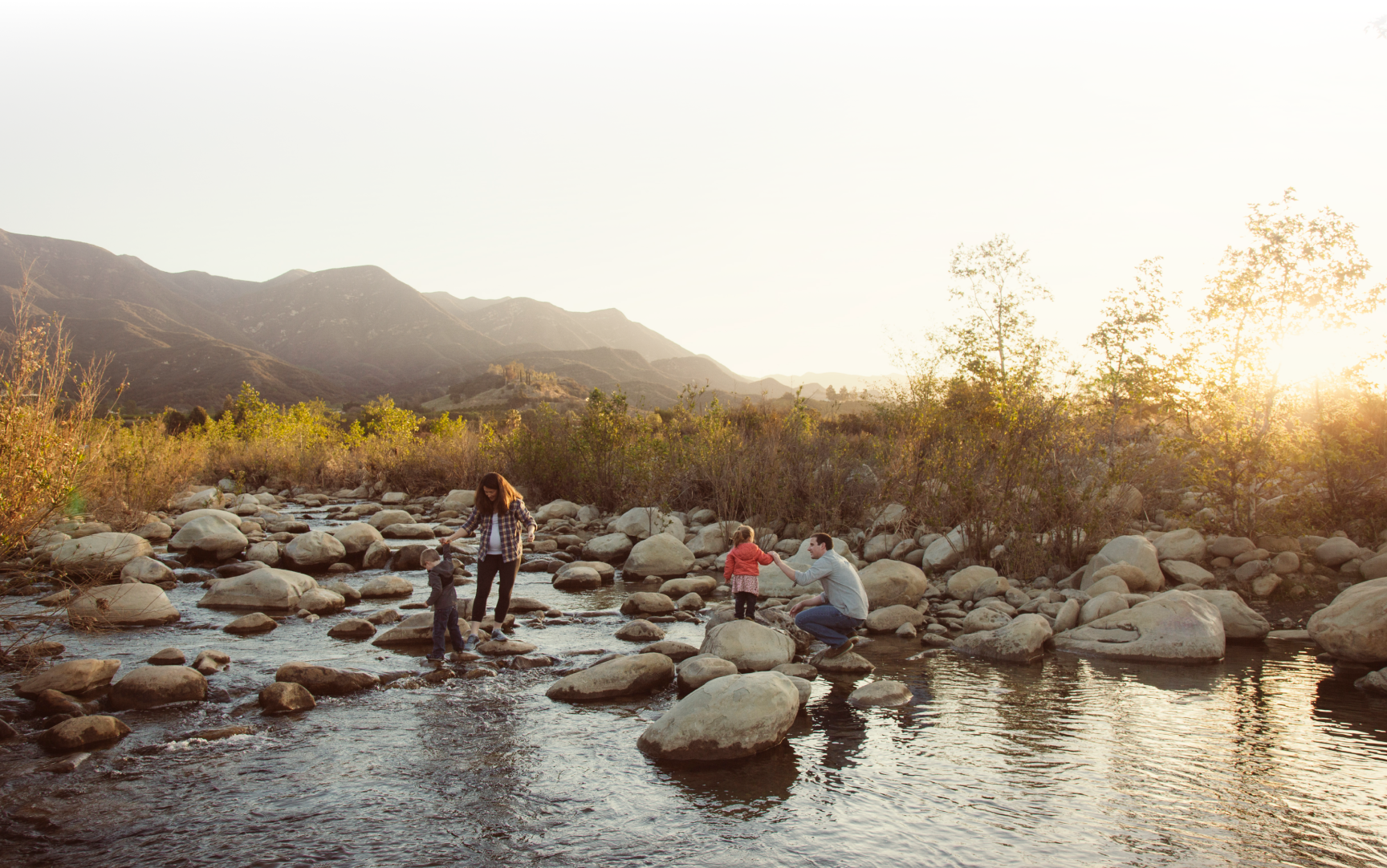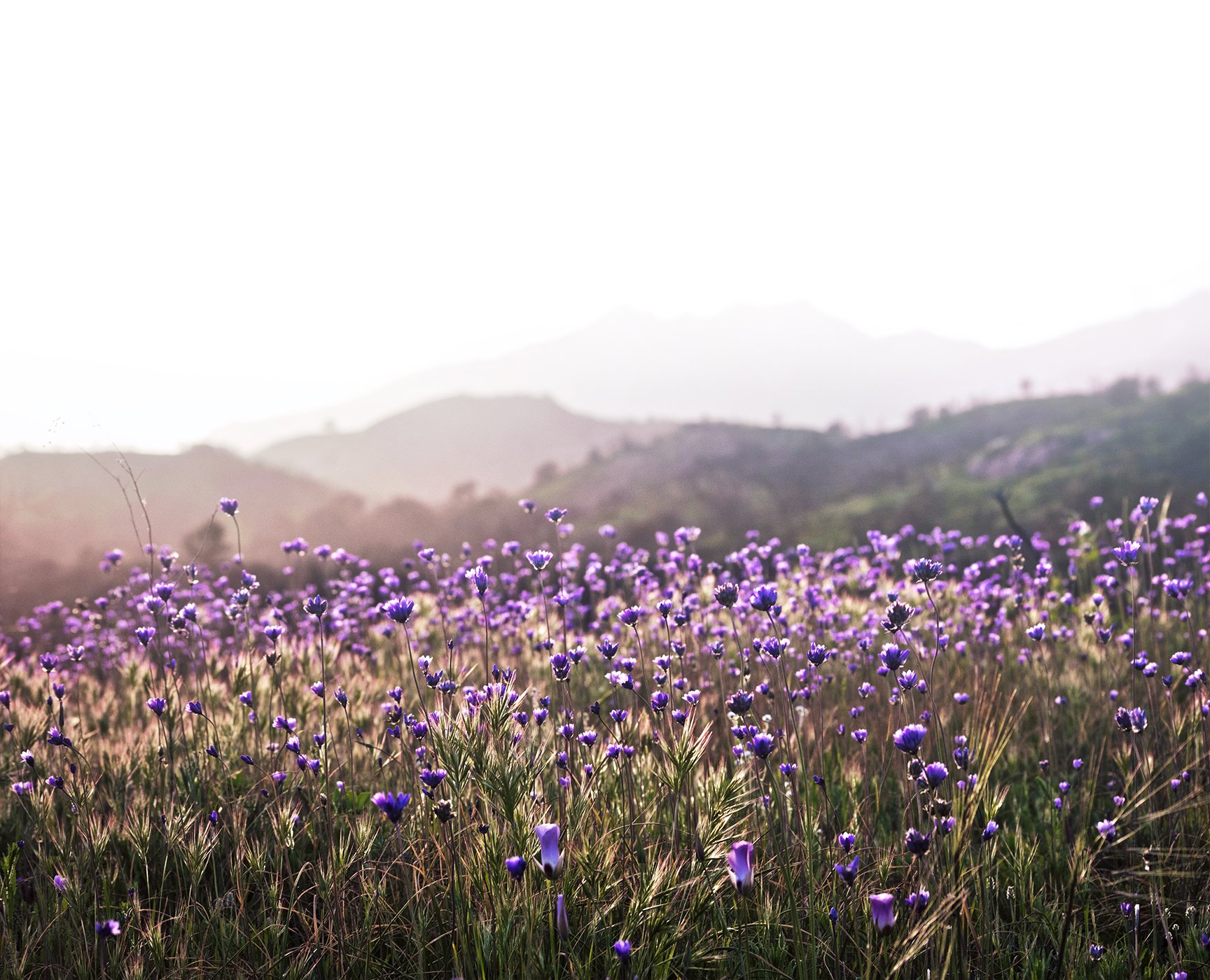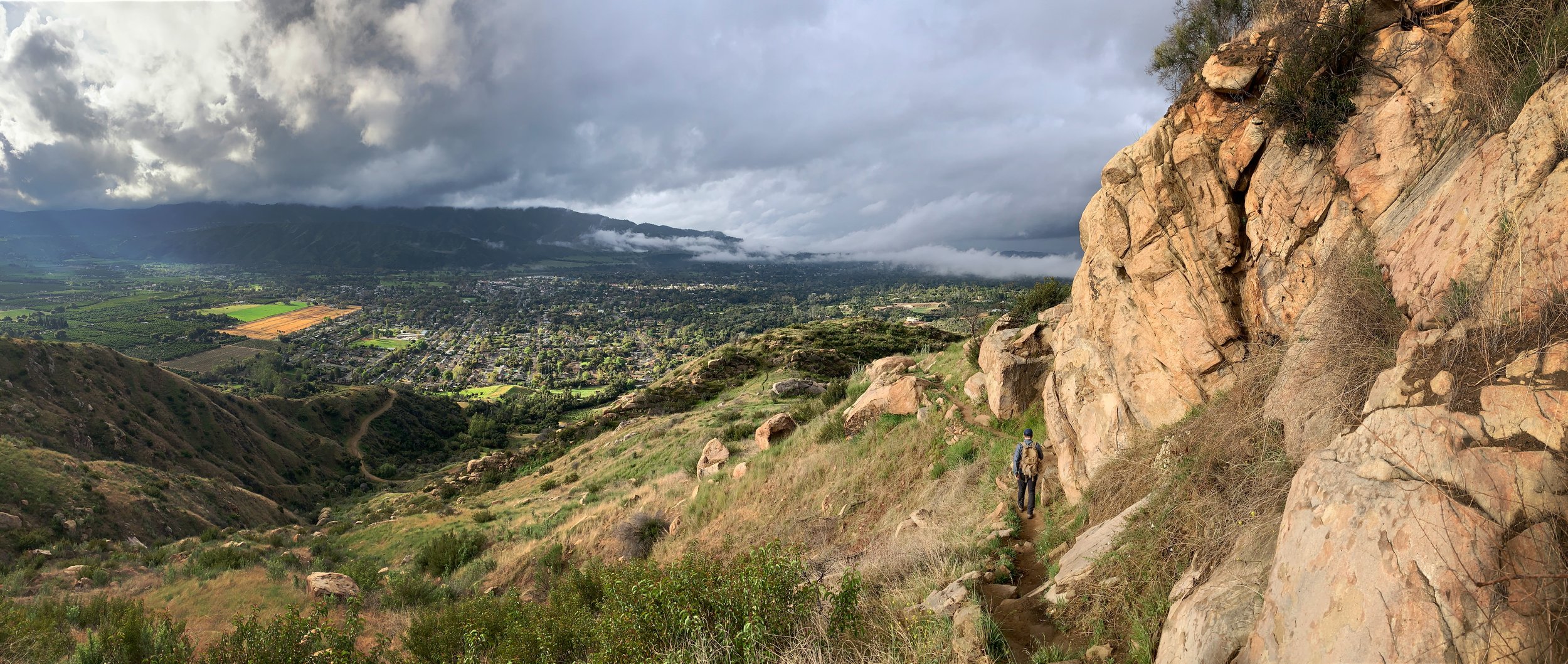
Programs
In the Ojai Valley, the OVLC manages roughly 2,300 acres of open space. On these lands, the OVLC maintains 27 miles of trail, guides hundreds of visitors, and hosts tens of thousands of school children, hikers, equestrians, and others each year.
Open space protected by the OVLC is preserved in perpetuity for the benefit of the community. Working with willing landowners on a voluntary basis, land is either protected by its acquisition or through a land conservation agreement. Our work falls into three program areas: Restoration, Stewardship, and Acquisition.

Land Protection
The Ojai Valley is known for its rural character and extraordinary views. Many elements come together to make Ojai a special place to live, work, and play: the smell of orange blossoms in the spring, the Pink Moment, miles of trails to explore, and families spending springtime at their favorite swimming holes. Protecting Ojai’s natural resources protects what makes Ojai special.
OVLC continues to prioritize acquisition of land and conservation easements in riparian areas, viewshed lands, lands adjacent to current preserves, and agricultural lands. However, with climate change intensifying the effects of heat and drought on our natural communities, OVLC is expanding our land protection priorities to include lands that foster climate resilience across the valley.
-
Acquisition of a parcel of land is the most direct form of land conservation. In an acquisition, OVLC obtains full ownership of a parcel of land for permanent protection and may open it for public access, protect it in its natural state, or restore it to improve ecological functions. We collaborate with willing landowners in the valley to acquire properties that fit our conservation goals.
-
A conservation easement is similar to other types of easements (such as a right of way easement) in that the landowner retains ownership of their land. A conservation easement restricts land uses that may harm the conservation values of the property and can also include restoration activities to enhance its condition. A conservation easement can be donated by or purchased from the landowner. Lands with conservation easements can still be sold or handed down to the next generation. Since lands with conservation easements are still private, most do not allow public access.
-
In addition to the satisfaction of knowing that your property will be protected in perpetuity, there are also some tax or financial benefits that may be available if land is donated in whole or in part. However, OVLC will also purchase land if funding can be obtained.
Conservation easements have value that can be bought or sold just like any other interest in land. While a conservation easement may be purchased, federal and state tax laws offer generous tax benefits for easement donations; a conservation easement may also help avoid or diminish an estate tax burden. Since each situation is unique, we encourage landowners to contact us to discuss their situation and goals.
-
If you’re interested in learning more about the different options that might be available and how you can make a permanent impact, please visit our Guide to Land Protection or reach out to us!
-
Please contact the Executive Director (executivedirector@ovlc.org or (805) 649-6852 x 1) if you have a property that you would like to have considered for preservation in perpetuity.
Restoration
In officially adding “restore” to our mission, OVLC is affirming our proactive approach to climate resilience. Our restoration program restores OVLC lands and riparian zones to enhance biodiversity. In addition, OVLC is expanding our reach to work with private landowners on strategic projects that will serve the whole community. In this way, we broaden our focus in our restoration work and target projects that enhance ecosystem services.
The restoration program has grown immensely in recent years, building upon two decades of experience, two hallmark projects including restoration of wetland habitat at the Ojai Meadows Preserve and orchard removal followed by oak woodland restoration at the Ventura River Preserve. OVLC also works to restore critical riparian habitats by removing giant reed or Arundo (Arundo donax) and other invasive riparian species from OVLC preserves along the Ventura River and in partnership with landowners on San Antonio Creek. This range and depth of experience is critical as OVLC works to lead conservation efforts in the Ventura River Watershed and the greater Ojai Valley area.
-
Every year OVLC plants hundreds of oak trees. These oak trees help the Ojai Valley become resilient to a changing climate. The oaks we plant today start off small and fragile, but with time they will become majestic towering oaks that define Ojai’s landscapes.
Restoring our lands back to oak woodlands has a myriad of benefits for our community and ecosystem, starting with Ojai’s iconic scenery.
Scenic Beauty: Oak woodlands and savannas make up the iconic scenery of the landscape in the Ojai Valley.
Try to imagine Ojai without any oaks: Wills Canyon in the Ventura River Preserve would not be the same magical place without oaks lining the trails, and we have all sought shade below the canopy of a gorgeous oak in the hot summer months.
Storing Carbon: Trees sequester carbon better than any other technology in the world. Oak trees remove carbon dioxide from the atmosphere through photosynthesis and release oxygen in return. This carbon is locked up in a tree’s roots, trunk, and branches, and effectively removed from the atmosphere for up to two hundred years!
Water: Oaks play an important role in protecting Ojai’s watersheds and water supply. The oak canopy slows the rain, decreases erosion of the soil, and improves the quality of the water in creeks, streams, and rivers. This slowing of the water flow, along with the extensive network of root channels which allow rainfall to penetrate Ojai’s hard clay soils, help recharge our groundwater supply. Oaks are also drought-tolerant and consume less water than non-native tree species.
Wildlife: Oaks provide habitat for thousands of species (flora and fauna) and influence the way the entire ecosystem operates. Hundreds of wildlife species rely on oaks for food and habitat and a diverse variety of native plants thrive in the shade of the canopy.
Fire: Oaks are adapted to fire, and can survive low intensity and infrequent fire events. A mature oak woodland with a closed canopy will even slow fast spreading wildland fire. Sadly, climate change and ignitions from unnatural causes have resulted in increased fire intensity and frequency, and our oaks are struggling to survive.
Climate: Even oak trees, which are adapted to our warm climate, are showing signs of stress from record temperature highs and extended drought. While they are resilient, we are already seeing the migration of native plants to cooler north-facing slopes. The shading and microclimates of a closed canopy oak forest is even more important today.
-
Visit our new Arundo page to learn more about our ongoing work!
Arundo (Arundo donax) is an invasive grass that infests and sometimes dominates the riparian ecosystems of Southern California watersheds, including here in the Ventura River. Arundo removal is a top priority for restoration at OVLC, as it is a noxious weed that can grow as high as 30 feet tall and impairs critical functions of our rivers and creeks.
This understanding is what compelled OVLC to launch the Ventura River Watershed Arundo Eradication Project - with the plan to map all the Arundo in the watershed, obtain permits for removal, conduct landowner outreach, implement projects strategically, and deploy an early detection-rapid response program. In 2021, OVLC used drones to survey 36 miles of riparian corridors and identified 69 acres of Arundo remaining in the upper watershed. After the historic floods of January 2023, OVLC surveyed the entire watershed, including the lower six miles of the mainstem from Foster Park to the Pacific Ocean. With Arundo mapped, OVLC is now in the permitting and landowner outreach phase, with plans to kick start implementation across the watershed in 2024.
Explore Our Map of Arundo in the Ventura River Watershed »
Guest Login
Username: OVLC_guest
Password: Arundo_2021Help Us Identify Arundo
Help OVLC locate Arundo (Arundo donax) in the Ventura River Watershed. Invasive Arundo consumes lots of water, outcompetes native vegetation, contributes to flooding, and poses a severe wildfire hazard. Locating and identifying Arundo will help OVLC in our effort to fully eradicate it from the watershed.
Other names for this noxious invasive: giant reed and elephant grass.
-
When it comes to Ojai’s biodiversity and resilience, this is a “just add water” landscape. Unfortunately, one of the most tangible effects of the changing climate is the dramatically heightened variability of rainfall and diminished flows in our creeks and rivers. This places a premium on innovative strategies to enhance water resilience.
Riparian corridors play a crucial role in nurturing the delicate balance that sustains our environment and community. These lush, green areas along waterways serve as vital habitats for diverse wildlife, including endangered species like the southwestern willow flycatcher (Empidonax trailii extimus) and steelhead trout (Oncorhynchus mykiss). Beyond their ecological significance, riparian corridors provide us with clean water, acting as natural filters for the creeks flowing through our valley. They also act as a protective shield against fire and flooding. In this interconnected web of life, they offer us peace, opportunities for recreation, and a profound connection to our beloved Ojai Valley.
-
Climate change is fueling landscape-scale effects that are fundamentally altering plant communities and damaging ecosystems. While OVLC has done extensive restoration work on our preserves and in riparian areas, we realize that the benefits are limited if we don’t enhance habitat on private lands to build connectivity. It is this understanding that has driven OVLC to pursue an initiative to Rewild Ojai.
OVLC’s new program increases the quantity and diversity of native plants grown in our nursery, initiates a seed conservation program (all plants grown in OVLC’s nursery come from seeds and cuttings collected sustainably from the Ojai Valley to protect and propagate local genotypes), and empowers all landowners to Rewild Ojai.
Stewardship
Our stewardship team works to manage and maintain our preserves, repair trails and infrastructure, all using best management practices.
-
Due to an increasing interest in outdoor recreation, OVLC trails are receiving more traffic than ever before. It's crucial for all trail users to respect each other's space, follow trail etiquette, and prioritize safety to ensure an enjoyable experience for everyone.
-
OVLC strives to connect people with the land, as we believe that engagement in nature is an important component of building support for our mission. Supporters who understand the value of open spaces and habitat will often help us achieve our goal of protecting and restoring more land in the Ojai Valley.
Trail management guides our efforts to maximize accessibility for all of our users, while also ensuring that we protect the natural resource values that OVLC has been entrusted to preserve.
-
The Ventura River and its surrounding ecosystem are valuable natural resources that provide numerous recreational opportunities while supporting a rich biodiversity of native flora and fauna. As users of this land, it is essential for us to understand and appreciate our relationship with the river and the land, and to take on the responsibility of being diligent stewards. By recognizing the value of this ecosystem and actively working towards its preservation, we can ensure its continued beauty and ecological integrity for generations to come.




